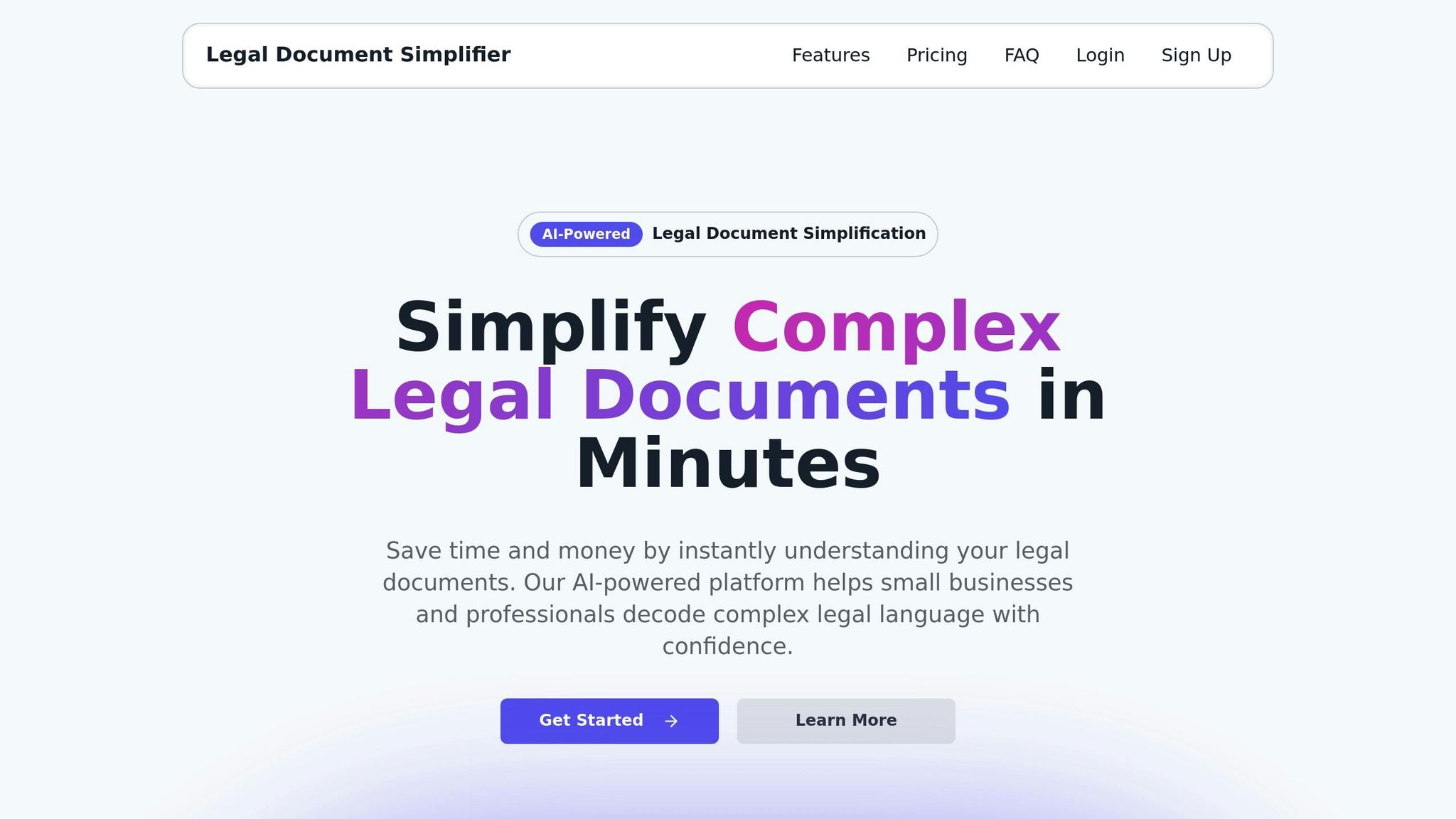
How to Read Legal Contracts: A Guide for Business Owners
Understanding legal contracts is essential for protecting your business. Misinterpreting or overlooking key details can lead to financial losses, unwanted obligations, or legal disputes. Whether you're dealing with local or international agreements, this guide simplifies the process of reviewing contracts effectively.
Key Takeaways:
- Main Parts of a Contract: Focus on the opening section, scope of work, payment terms, timelines, and legal clauses like force majeure and termination.
- Avoid Common Mistakes: Define all terms clearly, document verbal agreements, and take your time to review thoroughly.
- Simplify Legal Jargon: Use plain English to understand terms like indemnify, jurisdiction, and material breach.
- Leverage AI Tools: Tools like Legal Document Simplifier can translate legal text, highlight risks, and streamline your review process.
Before signing: Verify all terms, clarify unclear sections, and consult a legal expert for high-stakes agreements. Contracts shape your business relationships, so a careful review is critical to avoid costly mistakes.
Contracts 101: How To Read Contracts for Small Business ...
Main Parts of a Legal Contract
Understanding a contract's main components is essential for navigating it effectively.
Opening Section and Terms
This section sets the stage by identifying the involved parties, effective date, and providing necessary context. It includes:
- Parties and Dates: Lists the full legal names of the parties, their roles, and the agreement's start date.
- Recitals: Explains the background and purpose of the contract.
- Defined Terms: Highlights specific terms with unique meanings within the agreement.
Pay close attention to defined terms, especially if they include industry-specific jargon. If you're unsure about any terms, create a glossary to clarify their meanings and avoid misunderstandings.
Once you've reviewed this section, move on to the parts of the contract that outline responsibilities and obligations.
Must-Read Contract Sections
These sections outline the agreement's core details and should be reviewed carefully:
| Section | Key Details |
|---|---|
| Scope of Work | Describes deliverables, responsibilities, and expected outcomes. |
| Payment Terms | Covers amounts, payment schedules, late fees, and accepted payment methods. |
| Timeline | Includes important dates, milestones, and deadlines. |
| Performance Standards | Specifies quality requirements and acceptance criteria. |
| Rights and Obligations | Details the duties and responsibilities of each party. |
For agreements exceeding $500, ensure everything is documented in writing, as required by state law. If any section is unclear, take notes and address your concerns with the other party before signing.
Standard Legal Clauses
After reviewing the operational sections, focus on standard clauses designed to protect your interests. These typically include:
- Force Majeure: Explains what happens if unforeseen events prevent fulfilling the contract.
- Termination: Outlines the conditions under which the agreement can be ended.
- Dispute Resolution: Specifies how conflicts will be managed.
- Governing Law: Identifies which state's laws will apply.
- Confidentiality: Protects sensitive information shared between parties.
- Assignment: Defines rules for transferring rights under the contract.
Use a checklist to ensure these clauses are clear and negotiate any ambiguous wording. Boilerplate clauses can often be adjusted to better fit your specific needs.
Making Legal Terms Easy to Understand
Legal contracts often use complicated language that can make it hard to understand your responsibilities. Simplifying these terms into everyday language helps you clearly see your obligations and make smarter decisions.
Plain English Guide to Legal Terms
Here's a quick reference table that simplifies common legal jargon into plain English:
| Legal Term | Plain Translation | Application |
|---|---|---|
| Indemnify | Protect from financial loss | If your product causes harm, you’re responsible for covering the costs. |
| Force Majeure | Uncontrollable events | Covers natural disasters or emergencies that prevent fulfilling the contract. |
| Material Breach | Serious contract violation | A major failure that undermines the purpose of the agreement. |
| Jurisdiction | Legal authority area | Specifies which state’s courts will handle any disputes. |
| Severability | Independent clauses | If one part of the contract is invalid, the rest still applies. |
For instance, instead of saying, "The party of the first part shall remit payment", simplify it to "You must pay." Rewriting legal terms this way makes them easier to understand and sets the groundwork for AI tools to assist with contract review.
AI Tools for Contract Review
AI tools like Legal Document Simplifier take these translations a step further, turning dense legal text into clear, actionable language. Here's how they help:
-
Instant Translation
Quickly translates contracts into plain English, so you can understand your obligations without needing a lawyer right away. -
Key Term Highlighting
Automatically spots and explains important contract details, like financial responsibilities, deadlines, performance expectations, and termination clauses. Visual cues make these easier to identify. -
Document Analysis
The Professional plan ($79/month) offers features like automatic summaries of long contracts, risk identification in clauses, and side-by-side comparisons of original and simplified text for up to 50 documents each month.
While these tools can make legal language more accessible, always double-check their interpretations against the original text, especially for critical agreements.
sbb-itb-a9520de
4 Steps to Review Any Contract
Reviewing contracts doesn't have to feel daunting. By following these steps, you can identify key details and safeguard your business interests.
What to Check First
Start by focusing on these critical aspects in order of importance:
-
Parties and Basic Terms
Confirm the parties involved and the transaction details. Make sure the contract's purpose and scope align with your agreement. -
Financial Terms
Carefully review payment-related information, including amounts, schedules, penalties for late payments, currency details, additional fees, and tax obligations. -
Timeline and Deliverables
Map out important dates such as milestones, delivery schedules, and renewal periods. -
Termination Conditions
Understand the terms for ending the agreement, including notice periods, penalties for early termination, and any automatic renewal clauses.
Once you’ve covered these basics, dig deeper to spot potential issues that could lead to costly mistakes.
Common Contract Mistakes
Be aware of these frequent errors that can weaken a contract:
| Mistake | Impact | How to Avoid It |
|---|---|---|
| Undefined Terms | Leads to confusion and disputes | Clearly define all key terms |
| Template Gaps | Leaves out vital information | Fill in blanks and remove irrelevant sections |
| Verbal Side Agreements | Promises may not be enforceable | Document all agreements in writing |
| Rushed Review | Overlooks important details | Take the time needed for a thorough review |
Helpful Tips for Reviewing:
- Get input from multiple reviewers to catch different perspectives
- Clarify unclear terms to avoid misunderstandings
- Keep detailed notes during your review process
- For complex or high-stakes contracts, consult a legal professional
Using AI to Read Contracts Better
AI is changing the way contracts are reviewed by making the process faster and more accurate. These tools can analyze even the most complex contracts in less time. Here's how AI simplifies contract review.
What AI Brings to Contract Review
AI-driven tools offer several advanced features for contract analysis:
- Identify risks and unusual clauses: Quickly spot red flags in contracts.
- Extract key terms and obligations: Pull out the most important details automatically.
- Compare clauses: Match contract language against existing examples for consistency.
- Translate legal jargon: Turn complex legal terms into plain English instantly.
By learning from thousands of contracts, AI identifies patterns and potential issues, ensuring consistent results while saving time.
Legal Document Simplifier Tools

The Legal Document Simplifier showcases how AI can improve contract review through specific features:
| Feature | Purpose | How It Helps |
|---|---|---|
| AI Translation | Converts legal jargon to plain English | Makes contracts easier to understand |
| Key Point Extraction | Highlights critical contract details | Keeps focus on what matters |
| Risk Assessment | Identifies potential problems | Helps avoid costly mistakes |
| Document Comparison | Tracks changes between versions | Simplifies version control |
Pricing Plans
- Basic Plan ($29/month): Process up to 10 documents per month.
- Professional Plan ($79/month): Handle up to 50 documents monthly.
- Enterprise Plan: Custom pricing for unlimited document processing.
Getting Started with Legal Document Simplifier
Here’s how to begin using AI for contract review:
- Upload Your Document: Submit your contract in any common format.
- AI Analysis: The tool scans your document, pulling out key terms and flagging risks.
- Review Results: Use an interactive dashboard to review:
- Plain English summaries
- Key terms and conditions
- Risk analysis
- Suggested changes
- Collaborate: Share documents, add comments, and track updates in real time. Your data stays secure with end-to-end encryption.
Before You Sign: Key Steps
Once you've reviewed the contract, these final steps help ensure you're fully protected before making a commitment.
Key Questions to Ask
Before signing, make sure to ask:
- Does this contract fit with our business objectives?
- Are all verbal agreements included in writing?
- What are our responsibilities and potential risks?
- Are the termination and renewal terms fair?
- How will disagreements be handled?
Financial Considerations
- Are the payment terms and schedules clearly outlined?
- Are there any hidden costs or fees?
- What are the penalties for late payments or breaches?
Use the checklist below to confirm everything is in place before signing.
Pre-Signing Checklist
| Category | Items to Verify |
|---|---|
| Basic Elements | - Ensure no blank spaces remain - Verify company names and details - Check dates and deadlines |
| Key Terms | - Confirm payment amounts and schedules - Review delivery timelines - Ensure performance metrics are clear - Check renewal terms |
| Legal Protections | - Include confidentiality clauses - Verify indemnification terms - Confirm dispute resolution process - Identify governing law |
| Exit Strategy | - Review termination rights - Note required notice periods - Understand post-termination obligations |
Final Steps Before Signing
-
Thorough Review
Read the entire contract carefully - don’t skim. Pay special attention to financial terms, deadlines, and legal details. -
Seek Clarity
Flag any unclear sections and request written explanations. Ambiguous language can lead to problems later. -
Set Reminders
Add key dates to your calendar, such as payment schedules, renewal deadlines, and compliance requirements. -
Consult Legal Experts
For major contracts, have a lawyer review the document. They can spot risks and recommend additional protections.
Consider using Legal Document Simplifier's AI tools for an extra layer of review, but always rely on human judgment for the final check.
Conclusion
Carefully reviewing contracts is essential to protect your business and avoid costly mistakes. A well-written contract not only secures your interests but also helps build strong business relationships and manage risks effectively.
Legal agreements demand close attention and a methodical approach. While every contract needs a thorough review, modern AI tools can make this process much easier. For instance, Legal Document Simplifier breaks down complex legal terms into clear, actionable insights, enabling quicker and more informed decision-making.
Effective contract review combines human expertise with technology. Research indicates that combining human judgment with AI tools is 83% more effective than relying solely on automated redlines. This highlights the importance of a balanced approach. To manage contracts successfully, focus on these key practices:
- Review the entire contract thoroughly.
- Document any questions or concerns clearly.
- Confirm all verbal agreements in writing.
- Seek expert advice for critical contracts.
Each contract shapes your business relationships and legal responsibilities. By following these steps and using the right tools, you can safeguard your company’s interests while fostering strong, long-term partnerships.